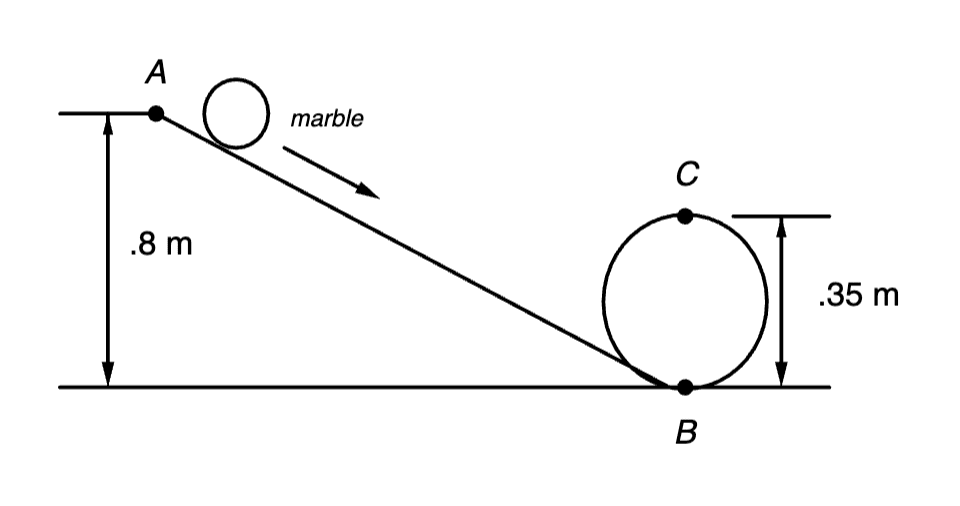Find the find the distance traveled by the plane and divide it by speed of the plane to get the time of travel.
| Step | Formula Derivation | Reasoning |
|---|---|---|
| 1 | a_{\text{centripetal}} = 8g | Maximum safe centripetal acceleration is 8 times the acceleration due to gravity ( g ). |
| 2 | a_{\text{centripetal}} = \frac{v^2}{r} | Centripetal acceleration formula, where v is velocity and r is the radius of the turn. |
| 3 | r = \frac{v^2}{a_{\text{centripetal}}} | Rearranging the formula to find the radius of the turn. |
| 4 | \theta = \frac{s}{r} | Relationship between angular displacement ( \theta in radians), arc length ( s ), and radius ( r ). |
| 5 | s = \pi r | For a 180° turn, \theta = \pi radians, so s = \pi r . |
| 6 | t = \frac{s}{v} | Time formula, where t is time, s is distance (arc length in this case), and v is velocity. |
| 7 | t = \frac{\pi r}{v} | Substituting s with \pi r . |
We will now calculate the time it takes for the airplane to make the 180° turn.
| Step | Formula Derivation | Reasoning |
|---|---|---|
| 8 | t \approx 16.01 , \text{s} | Calculated time for the 180° turn. |
The time it takes for the airplane to make a 180° turn at a constant speed of 400 m/s, subjected to a centripetal acceleration of 8 g’s, is approximately \boxed{16.01 , \text{seconds}} .
Phy can also check your working. Just snap a picture!

The diagram above shows a marble rolling down an incline, the bottom part of which has been bent into a loop. The marble is released from point A at a height of 0.80 m above the ground. Point B is the lowest point and point C the highest point of the loop. The diameter of the loop is 0.35 m. The mass of the marble is 0.050 kg. Friction forces and any gain in kinetic energy due to the rotating of the marble can be ignored. When answering the following questions, consider the marble when it is at point C.
A conical pendulum is formed by attaching a ball of mass m to a string of length L, then allowing the ball to move in a horizontal circle of radius R.
Suppose you are a passenger traveling in car along a road that bends to the left. Why will you feel like you are being thrown against the door. What causes this force?
Riders in a carnival ride stand with their backs against the wall of a circular room of diameter 8.0 m. The room is spinning horizontally about an axis through its center at a rate of 45 rev/min when the floor drops so that it no longer provides any support for the riders. What is the minimum coefficient of static friction between the wall and the rider required so that the rider does not slide down the wall?
A 2.00 x102 g block on a 50.0 cm long string swings in a circle on a horizontal, frictionless table at 75.0 rpm. What is the speed of block? What is the tension in the string?
16.01 seconds
By continuing you (1) agree to our Terms of Sale and Terms of Use and (2) consent to sharing your IP and browser information used by this site’s security protocols as outlined in our Privacy Policy.
| Kinematics | Forces |
|---|---|
| \Delta x = v_i t + \frac{1}{2} at^2 | F = ma |
| v = v_i + at | F_g = \frac{G m_1m_2}{r^2} |
| a = \frac{\Delta v}{\Delta t} | f = \mu N |
| R = \frac{v_i^2 \sin(2\theta)}{g} |
| Circular Motion | Energy |
|---|---|
| F_c = \frac{mv^2}{r} | KE = \frac{1}{2} mv^2 |
| a_c = \frac{v^2}{r} | PE = mgh |
| KE_i + PE_i = KE_f + PE_f |
| Momentum | Torque and Rotations |
|---|---|
| p = m v | \tau = r \cdot F \cdot \sin(\theta) |
| J = \Delta p | I = \sum mr^2 |
| p_i = p_f | L = I \cdot \omega |
| Simple Harmonic Motion |
|---|
| F = -k x |
| T = 2\pi \sqrt{\frac{l}{g}} |
| T = 2\pi \sqrt{\frac{m}{k}} |
| Constant | Description |
|---|---|
| g | Acceleration due to gravity, typically 9.8 , \text{m/s}^2 on Earth’s surface |
| G | Universal Gravitational Constant, 6.674 \times 10^{-11} , \text{N} \cdot \text{m}^2/\text{kg}^2 |
| \mu_k and \mu_s | Coefficients of kinetic (\mu_k) and static (\mu_s) friction, dimensionless. Static friction (\mu_s) is usually greater than kinetic friction (\mu_k) as it resists the start of motion. |
| k | Spring constant, in \text{N/m} |
| M_E = 5.972 \times 10^{24} , \text{kg} | Mass of the Earth |
| M_M = 7.348 \times 10^{22} , \text{kg} | Mass of the Moon |
| M_M = 1.989 \times 10^{30} , \text{kg} | Mass of the Sun |
| Variable | SI Unit |
|---|---|
| s (Displacement) | \text{meters (m)} |
| v (Velocity) | \text{meters per second (m/s)} |
| a (Acceleration) | \text{meters per second squared (m/s}^2\text{)} |
| t (Time) | \text{seconds (s)} |
| m (Mass) | \text{kilograms (kg)} |
| Variable | Derived SI Unit |
|---|---|
| F (Force) | \text{newtons (N)} |
| E, PE, KE (Energy, Potential Energy, Kinetic Energy) | \text{joules (J)} |
| P (Power) | \text{watts (W)} |
| p (Momentum) | \text{kilogram meters per second (kgm/s)} |
| \omega (Angular Velocity) | \text{radians per second (rad/s)} |
| \tau (Torque) | \text{newton meters (Nm)} |
| I (Moment of Inertia) | \text{kilogram meter squared (kgm}^2\text{)} |
| f (Frequency) | \text{hertz (Hz)} |
General Metric Conversion Chart
Example of using unit analysis: Convert 5 kilometers to millimeters.
Start with the given measurement: \text{5 km}
Use the conversion factors for kilometers to meters and meters to millimeters: \text{5 km} \times \frac{10^3 \, \text{m}}{1 \, \text{km}} \times \frac{10^3 \, \text{mm}}{1 \, \text{m}}
Perform the multiplication: \text{5 km} \times \frac{10^3 \, \text{m}}{1 \, \text{km}} \times \frac{10^3 \, \text{mm}}{1 \, \text{m}} = 5 \times 10^3 \times 10^3 \, \text{mm}
Simplify to get the final answer: \boxed{5 \times 10^6 \, \text{mm}}
Prefix | Symbol | Power of Ten | Equivalent |
|---|---|---|---|
Pico- | p | 10^{-12} | 0.000000000001 |
Nano- | n | 10^{-9} | 0.000000001 |
Micro- | µ | 10^{-6} | 0.000001 |
Milli- | m | 10^{-3} | 0.001 |
Centi- | c | 10^{-2} | 0.01 |
Deci- | d | 10^{-1} | 0.1 |
(Base unit) | – | 10^{0} | 1 |
Deca- or Deka- | da | 10^{1} | 10 |
Hecto- | h | 10^{2} | 100 |
Kilo- | k | 10^{3} | 1,000 |
Mega- | M | 10^{6} | 1,000,000 |
Giga- | G | 10^{9} | 1,000,000,000 |
Tera- | T | 10^{12} | 1,000,000,000,000 |
The most advanced version of Phy. Currently 50% off, for early supporters.
per month
Billed Monthly. Cancel Anytime.
Trial –> Phy Pro
A quick explanation
UBQ credits are specifically used to grade your FRQs and GQs.
You can still view questions and see answers without credits.
Submitting an answer counts as 1 attempt.
Seeing answer or explanation counts as a failed attempt.
Lastly, check your average score, across every attempt, in the top left.
MCQs are 1 point each. GQs are 1 point. FRQs will state points for each part.
Phy can give partial credit for GQs & FRQs.
Phy sees everything.
It customizes responses, explanations, and feedback based on what you struggle with. Try your best on every question!
Understand you mistakes quicker.

For GQs and FRQs, Phy provides brief feedback as to how you can improve your answer.
Aim to increase your understadning and average score with every attempt!
10 Free Credits To Get You Started
*Phy Pro members get unlimited credits

By continuing you agree to nerd-notes.com Terms of Service, Privacy Policy, and our usage of user data.